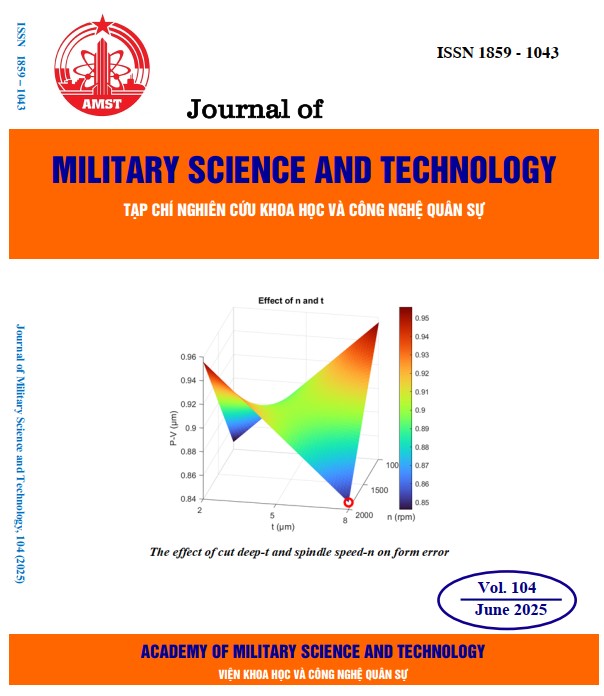Phân tích trào lưu công suất nhiều khoảng thời gian cho lưới điện phân phối có nguồn điện phân tán sử dụng mô hình tối ưu phi tuyến
295 lượt xemDOI:
https://doi.org/10.54939/1859-1043.j.mst.104.2025.49-58Từ khóa:
Phân tích trào lưu công suất nhiều khoảng thời gian (MPF); Tối ưu phi tuyến (NLP); Nguồn điện phân tán (DG).Tóm tắt
Phân tích trào lưu công suất truyền thống thường chỉ được thực hiện trong một khoảng thời gian. Tuy nhiên, nhiều bài toán trong hệ thống điện như tính toán tổn thất điện năng, tối ưu vị trí và công suất tụ bù yêu cầu phân tích trào lưu công suất theo nhiều khoảng thời gian. Bài báo này đề xuất một phương pháp dựa trên tối ưu phi tuyến (NLP) để tính toán trào lưu công suất nhiều khoảng thời gian (MPF) cho lưới điện phân phối có nguồn điện phân tán (DG). Mô hình NLP có hàm mục tiêu hằng số và các ràng buộc là hệ phương trình cân bằng công suất với giá trị cố định của mô-đun và góc pha điện áp tại nút cân bằng. Mô hình được lập trình bằng GAMS và giải bằng bộ tối ưu KNITRO. Phương pháp được kiểm chứng trên lưới điện phân phối huyện Lục Ngạn, Bắc Giang với 54 nút, 96 khoảng thời gian. Kết quả tính toán cho thấy phương pháp đề xuất có sai số rất nhỏ so với phương pháp Newton-Raphson truyền thống. Đồng thời, DG có ảnh hưởng đáng kể đến tổn thất điện năng và chất lượng điện áp của lưới phân phối.
Tài liệu tham khảo
[1]. X. Zhang, B. Deng, Z. Pan, and T. Yu, “A linear programming-based framework of interval power flow analysis for distribution systems,” International Journal of Electrical Power & Energy Systems, vol. 167, p. 110638, (2025), doi: 10.1016/j.ijepes.2025.110638. DOI: https://doi.org/10.1016/j.ijepes.2025.110638
[2]. H. Lin, F. Ui Nazir, B. C. Pal, and Y. Guo, “A Linearized Branch Flow Model Considering Line Shunts for Radial Distribution Systems and Its Application in Volt/VAr Control,” Journal of Modern Power Systems and Clean Energy, vol. 11, no. 4, pp. 1191–1200, (2023), doi: 10.35833/MPCE.2022.000382. DOI: https://doi.org/10.35833/MPCE.2022.000382
[3]. S. V. Dhople, Y. C. Chen, A. Al-Digs, and A. D. Domínguez-García, “Reexamining the Distributed Slack Bus,” IEEE Transactions on Power Systems, vol. 35, no. 6, pp. 4870–4879, (2020), doi: 10.1109/TPWRS.2020.2987325. DOI: https://doi.org/10.1109/TPWRS.2020.2987325
[4]. A. G. Fonseca, O. L. Tortelli, and E. M. Lourenço, “Extended fast decoupled power flow for recon-figuration networks in distribution systems,” IET Generation, Transmission & Distribution, vol. 12, no. 22, pp. 6033–6040, (2018), doi: 10.1049/iet-gtd.2018.5886. DOI: https://doi.org/10.1049/iet-gtd.2018.5886
[5]. N. Costilla-Enriquez, Y. Weng, and B. Zhang, “Combining Newton-Raphson and Stochastic Gradi-ent Descent for Power Flow Analysis,” IEEE Transactions on Power Systems, vol. 36, no. 1, pp. 514–517, (2021), doi: 10.1109/TPWRS.2020.3029449. DOI: https://doi.org/10.1109/TPWRS.2020.3029449
[6]. M. Atanasovski and R. Taleski, “Power Summation Method for Loss Allocation in Radial Distribu-tion Networks With DG,” IEEE Transactions on Power Systems, vol. 26, no. 4, pp. 2491–2499, (2011), doi: 10.1109/TPWRS.2011.2153216. DOI: https://doi.org/10.1109/TPWRS.2011.2153216
[7]. G. C. Kryonidis, E. O. Kontis, A. I. Chrysochos, K. O. Oureilidis, C. S. Demoulias, and G. K. Papagi-annis, “Power Flow of Islanded AC Microgrids: Revisited,” IEEE Transactions on Smart Grid, vol. 9, no. 4, pp. 3903–3905, (2018), doi: 10.1109/TSG.2018.2799480. DOI: https://doi.org/10.1109/TSG.2018.2799480
[8]. W. Lin, Y. Chen, Q. Li, and C. Zhao, “An AC-Feasible Linear Model in Distribution Networks With Energy Storage,” IEEE Trans. Power Syst., vol. 39, no. 1, pp. 1224–1239, (2024), doi: 10.1109/TPWRS.2023.3244959. DOI: https://doi.org/10.1109/TPWRS.2023.3244959
[9]. T. Yang, Y. Guo, L. Deng, H. Sun, and W. Wu, “A Linear Branch Flow Model for Radial Distribution Networks and Its Application to Reactive Power Optimization and Network Reconfiguration,” IEEE Transactions on Smart Grid, vol. 12, no. 3, pp. 2027–2036, (2021), doi: 10.1109/TSG.2020.3039984. DOI: https://doi.org/10.1109/TSG.2020.3039984
[10]. R. A. Jabr, “Radial distribution load flow using conic programming,” IEEE Transactions on Power Systems, vol. 21, no. 3, pp. 1458–1459, (2006), doi: 10.1109/TPWRS.2006.879234. DOI: https://doi.org/10.1109/TPWRS.2006.879234
[11]. R. A. Jabr, “A Conic Quadratic Format for the Load Flow Equations of Meshed Networks,” IEEE Transactions on Power Systems, vol. 22, no. 4, pp. 2285–2286, (2007), doi: 10.1109/TPWRS.2007.907590. DOI: https://doi.org/10.1109/TPWRS.2007.907590
[12]. S. M. Lutful Kabir, A. H. Chowdhury, M. Rahman, and J. Alam, “Inclusion of slack bus in Newton Raphson load flow study,” in 8th International Conference on Electrical and Computer Engineering, (2014), pp. 282–284. doi: 10.1109/ICECE.2014.7026900. DOI: https://doi.org/10.1109/ICECE.2014.7026900
[13]. GAMS Development Corp., “GAMS Documentation 46.” Feb. 17, 2024. Accessed: Feb. 25, 2025. [Online]. Available: https://www.gams.com.
[14]. R. D. Zimmerman, C. E. Murillo-Sanchez, and R. J. Thomas, “MATPOWER: Steady-State Operations, Planning, and Analysis Tools for Power Systems Research and Education,” IEEE Trans. Power Syst., vol. 26, no. 1, pp. 12–19, (2011), doi: 10.1109/TPWRS.2010.2051168. DOI: https://doi.org/10.1109/TPWRS.2010.2051168







